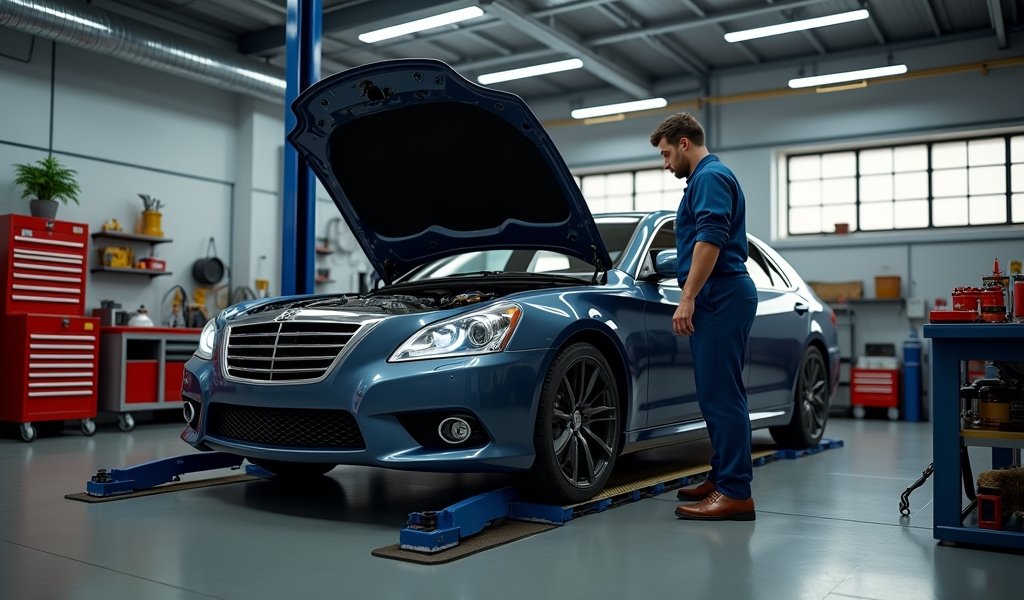Overview
This article explains how cooling fan relays work in vehicles and provides five fixes for common issues: testing/replacing the relay, checking wiring connections, evaluating temperature sensors, inspecting fuses, and assessing the fan motor itself. Regular preventative maintenance is recommended to avoid cooling system failures, which can lead to expensive engine damage if ignored.
Table of Contents
- Understanding Cooling Fan Relays
- Symptoms of Cooling Fan Relay Problems
- Fix #1: Testing and Replacing the Relay
- Fix #2: Checking Wiring and Connections
- Fix #3: Temperature Sensor Evaluation
- Fix #4: Inspecting Fuses
- Fix #5: Fan Motor Assessment
- Preventative Maintenance
- Conclusion
- Frequently Asked Questions
Understanding Cooling Fan Relays
Your vehicle’s cooling system is a marvel of engineering, and the cooling fan relay serves as its unsung hero. This small electrical component acts as the critical middleman between your engine control module (ECM) and cooling fans, ensuring your engine maintains optimal temperature.
Think of the cooling fan relay as a temperature-triggered switch. When your engine heats up beyond normal operating range, the ECM sends a signal to the relay, which closes its internal circuit and allows current to flow to the cooling fan motor. This seemingly simple operation prevents catastrophic engine overheating issues that could leave you stranded or facing expensive repairs.
Most modern vehicles utilize electric cooling fans controlled by these relays, rather than the belt-driven fans of yesteryear. This electronic control allows for precise temperature management and improved fuel efficiency since the fan only runs when actually needed.
Symptoms of Cooling Fan Relay Problems
How can you tell when your cooling fan relay is waving the white flag? Several telltale signs should trigger your mechanical spider-sense:
- Engine temperature climbing higher than Mount Everest on your gauge
- Cooling fan never activating, even when the engine is hot enough to fry an egg
- Fan running constantly, regardless of engine temperature (even when cold)
- Intermittent fan operation when it should be running continuously
- Air conditioning performance dropping when sitting idle
Ignoring these symptoms is like ignoring chest pain – it might go away, but the consequences could be dire. An overheating engine quickly cascades from nuisance to nightmare, potentially leading to warped cylinder heads, blown gaskets, or even complete engine failure. According to AA1Car.com’s cooling system experts, nearly 40% of engine failures can be traced back to cooling system problems.

Fix #1: Testing and Replacing the Relay
When troubleshooting cooling fan issues, start with the most straightforward fix – the relay itself. These components eventually wear out from thousands of on-off cycles.
First, you’ll need to locate the cooling fan relay. Check your owner’s manual, but it’s typically found in the main fuse box under the hood (often near the battery) or in a secondary relay panel. It resembles a small plastic cube with electrical connections on the bottom, usually labeled on the fuse box cover diagram.
To test a suspect relay:
- With the engine off, remove the cooling fan relay
- Examine the relay diagram (printed on the relay or fuse box cover)
- Give it a gentle shake – if you hear rattling, it’s definitely bad
- Use a multimeter set to continuity mode to check for proper operation between terminals
- Try the “relay swap test” – substitute another identical relay from your fuse box temporarily
If the test confirms your relay has gone to electrical component heaven, replacement is straightforward:
- Purchase a matching relay (verify part numbers for compatibility)
- Ensure the ignition is turned off
- Remove the old relay by pulling straight up
- Install the new relay, making sure it seats fully
- Start the engine and monitor temperature to confirm proper operation
This repair typically costs $15-25 for the relay itself, and requires no special tools beyond perhaps a pair of needle-nose pliers. Even mechanical novices can handle this fix with confidence.
Fix #2: Checking Wiring and Connections
If the relay checks out fine, the electrical pathways connecting your cooling system components might be the culprits. Wiring problems can perfectly mimic relay failures, sending you down the wrong diagnostic path.
Over the years, I’ve seen countless cooling system issues traced to wiring gremlins:
- Corroded connections creating high resistance
- Damaged wire insulation causing shorts
- Loose connectors creating intermittent operation
- Ground points that have become compromised
- Rodent damage (those little rascals love wire insulation)
To inspect your cooling fan wiring:
- Always disconnect your battery before handling electrical components
- Follow the wiring harness from the relay to the fan motor
- Check each connection for corrosion, damage, or looseness
- Pay special attention to ground connections – they’re often overlooked
- Look for any signs of melted insulation, which indicates excessive current draw
Addressing these issues requires basic supplies: electrical contact cleaner, dielectric grease, electrical tape, and possibly some replacement wire or connectors. For badly corroded terminals, a gentle scrub with a wire brush often works wonders. I’ve saved countless customers hundreds of dollars with just these simple fixes.
Remember that proper radiator hose inspection should also be part of your cooling system checkup, as these rubber components can degrade over time and cause system failures.
Fix #3: Temperature Sensor Evaluation
Sometimes the issue isn’t with the fan circuit itself, but with the information feeding it. Your vehicle’s engine coolant temperature sensor (CTS) provides the crucial data that determines when those cooling fans should kick on.
When this sensor goes haywire, it’s like having a faulty thermometer during a fever – your vehicle’s computer receives incorrect temperature readings and makes poor decisions about fan operation. The result? Fans that run constantly (if the sensor reads too hot) or never activate (if the sensor reads too cold).
Signs pointing to a temperature sensor issue include:
- Erratic temperature gauge readings
- Cooling fan operating when the engine is cold
- Fan failing to activate even when the engine is obviously hot
- Check engine light with temperature-related codes
- Poor fuel economy and engine performance
Testing your temperature sensor requires a multimeter and basic knowledge of resistance testing:
- Locate the sensor (usually threaded into the engine block or cylinder head)
- With the engine cold, disconnect the sensor connector
- Set your multimeter to measure ohms (resistance)
- Check resistance across sensor terminals (consult your specific vehicle specifications)
- The resistance should decrease predictably as the engine warms up
Replacing a faulty sensor is relatively straightforward on most vehicles, though access can sometimes be challenging. According to MotorTrend’s maintenance experts, this repair typically requires cooling system drainage and refilling, so be prepared with fresh coolant and bleeding procedures specific to your vehicle.

Fix #4: Inspecting Fuses
Sometimes the simplest explanations are the correct ones. A blown fuse can completely disable your cooling fan circuit, and it’s often overlooked during diagnostics.
Your cooling system typically has multiple fuses protecting different circuit segments. You’ll need to check your owner’s manual or the fuse box diagram to identify the specific fuses associated with your cooling fan system. Most vehicles have separate fuses for:
- The cooling fan relay control circuit
- The high-speed fan circuit
- The low-speed fan circuit (if equipped)
- The engine control module (which governs the entire system)
Checking fuses is delightfully simple:
- Locate and open the appropriate fuse box
- Use the fuse puller tool (usually included in the box) to extract suspect fuses
- Hold the fuse up to light – a blown fuse will show a visibly broken metal strip
- Replace any blown fuses with identical amperage ratings
- Never substitute a higher amperage fuse – this can cause electrical fires!
Here’s a pearl of wisdom from my decades in the shop: If a replacement fuse immediately blows again, stop and investigate further. This indicates a short circuit or excessive current draw elsewhere in the system, often in the fan motor itself. Continuing to replace blown fuses without addressing the underlying cause is like treating symptoms while ignoring the disease.
Fix #5: Fan Motor Assessment
When all other components check out, the cooling fan motor itself might be the problem child. Electric motors have a finite lifespan, especially considering the harsh under-hood environment they operate in.
Fan motors can fail in several ways:
- Complete electrical failure (open circuit)
- Internal shorts causing excessive current draw
- Worn bearings creating mechanical resistance
- Partial winding failure causing inconsistent operation
To test your cooling fan motor:
- With the engine cold and off, check if the fan spins freely by hand (where accessible)
- Listen for unusual grinding or scraping when the fan operates
- Disconnect the fan connector and apply battery power directly with appropriate jumper wires
- If the fan doesn’t run with direct power, the motor is definitely faulty
- If it does run, the issue lies in the control circuit
Replacing a cooling fan motor varies significantly in complexity depending on your vehicle. Some designs allow for simple motor replacement, while others require changing the entire fan assembly. This job typically costs $75-300 for parts, with labor adding $100-300 depending on your vehicle’s design and local labor rates.
For DIYers, I recommend searching for vehicle-specific tutorials online before diving in. Some models require partial radiator removal or other complex disassembly that can intimidate even experienced home mechanics.
Preventative Maintenance
An ounce of prevention is worth a gallon of coolant! Regular cooling system maintenance dramatically reduces your chances of facing cooling fan relay problems.
My preventative maintenance recommendations include:
- Flush and replace coolant according to manufacturer schedules (typically every 30,000-60,000 miles)
- Visually inspect all cooling system components during routine oil changes
- Clean debris from the radiator and condenser surfaces annually
- Listen for changes in cooling fan operation – early detection saves money
- Address minor temperature fluctuations before they become major problems
Pay particular attention to your cooling system before extreme seasons. Summer heat places maximum demands on your cooling system, while winter brings its own set of challenges. A cooling system pressure test, performed at most repair shops for $30-50, can identify weaknesses before they strand you on the roadside.
Conclusion
Your vehicle’s cooling fan relay may be small, but its importance to your engine’s health can’t be overstated. From simple relay swaps to more involved wiring repairs, these five fixes address the most common cooling fan relay problems you’re likely to encounter on the road.
Remember that cooling system issues should never be ignored – they’re your vehicle’s way of waving a red flag before serious damage occurs. Most of these repairs fall well within the capabilities of motivated DIYers, but don’t hesitate to consult a professional if you’re uncomfortable working with electrical systems or if multiple repair attempts haven’t solved the issue.
By understanding how your cooling fan relay operation impacts your vehicle’s temperature management, you’re empowered to make informed maintenance decisions that can save you thousands in potential engine repairs. Stay cool out there!
Frequently Asked Questions
How do I know if my cooling fan relay is bad?
Look for an engine that overheats when idling but cools when driving, or a cooling fan that never activates. You can also swap the relay with an identical one from your vehicle to quickly test if the relay is the problem.
Can I drive with a bad cooling fan relay?
It’s not recommended as your engine may overheat quickly in traffic or at idle. Even short drives with an overheating engine can cause expensive damage to head gaskets and other components.
How much does it cost to replace a cooling fan relay?
The part typically costs $15-30, and labor is minimal if you know the relay location. DIY replacement is straightforward and requires no special tools.
Why does my cooling fan run constantly?
A constantly running fan usually indicates a stuck relay, faulty temperature sensor, or a short circuit in the wiring. Check the relay first, as it’s the most common culprit and easiest to fix.
Can a bad cooling fan relay cause the check engine light to come on?
Yes, when cooling problems cause engine temperature to exceed programmed limits. Modern engine computers monitor temperature closely and will trigger warning lights when cooling system issues are detected.

